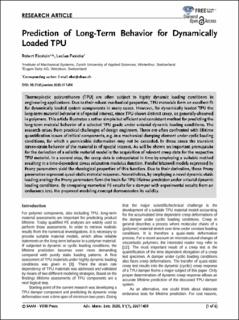Please use this identifier to cite or link to this item:
https://doi.org/10.21256/zhaw-19705| Publication type: | Article in scientific journal |
| Type of review: | Peer review (publication) |
| Title: | Prediction of long-term behavior for dynamically loaded TPU |
| Authors: | Eberlein, Robert Pasieka, Lucian |
| et. al: | No |
| DOI: | 10.5185/amlett.2020.011458 10.21256/zhaw-19705 |
| Published in: | Advanced Materials Letters |
| Volume(Issue): | 11 |
| Issue: | 1 |
| Page(s): | 1 |
| Pages to: | 6 |
| Issue Date: | Jan-2020 |
| Publisher / Ed. Institution: | VBRI Press |
| ISSN: | 0976-3961 0976-397X |
| Language: | English |
| Subjects: | TPU; Creep; Relaxation; Lifetime Prediction; System Validation; FE Simulation |
| Subject (DDC): | 620.11: Engineering materials |
| Abstract: | Thermoplastic polyurethanes (TPU) are often subject to highly dynamic loading conditions in engineering applications. Due to their robust mechanical properties, TPU materials form an excellent fit for dynamically loaded system components in many cases. However, for dynamically loaded TPU the long-term material behavior is of special interest, since TPU shows distinct creep, as generally observed in polymers. This article illustrates a rather simple but efficient and consistent method for predicting the long-term material behavior of a selected TPU grade under uniaxial dynamic loading conditions. The research arises from practical challenges of design engineers. These are often confronted with lifetime quantification issues of critical components, e.g. in a mechanical damping element under cyclic loading conditions, for which a permissible deformation may not be exceeded. In those cases the transient stress-strain behavior of the material is of special interest. As will be shown an important prerequisite for the derivation of a reliable material model is the acquisition of relevant creep data for the respective TPU material. In a second step, the creep data is extrapolated in time by employing a suitable method resulting in a time-dependent stress relaxation modulus function. Parallel Maxwell models expressed by Prony parameters yield the rheological properties of this function. Due to their derivation, these Prony parameters represent quasi-static material response. Nevertheless, by employing a novel dynamic-static loading analogy the Prony parameters form the basis for TPU lifetime prediction under uniaxial dynamic loading conditions. By comparing numerical FE results for a damper with experimental results from an endurance test, the proposed modeling concept demonstrates its validity. |
| URI: | https://digitalcollection.zhaw.ch/handle/11475/19705 |
| Fulltext version: | Published version |
| License (according to publishing contract): | Licence according to publishing contract |
| Departement: | School of Engineering |
| Organisational Unit: | Institute of Mechanical Systems (IMES) |
| Appears in collections: | Publikationen School of Engineering |
Files in This Item:
| File | Description | Size | Format | |
|---|---|---|---|---|
| 2020_Eberlein_Prediction_of_Long-Term_Behavior_for_Dynamically_Loaded_TPU_Advanced_Materials_Letters.pdf | 749.5 kB | Adobe PDF |  View/Open |
Show full item record
Eberlein, R., & Pasieka, L. (2020). Prediction of long-term behavior for dynamically loaded TPU. Advanced Materials Letters, 11(1), 1–6. https://doi.org/10.5185/amlett.2020.011458
Eberlein, R. and Pasieka, L. (2020) ‘Prediction of long-term behavior for dynamically loaded TPU’, Advanced Materials Letters, 11(1), pp. 1–6. Available at: https://doi.org/10.5185/amlett.2020.011458.
R. Eberlein and L. Pasieka, “Prediction of long-term behavior for dynamically loaded TPU,” Advanced Materials Letters, vol. 11, no. 1, pp. 1–6, Jan. 2020, doi: 10.5185/amlett.2020.011458.
EBERLEIN, Robert und Lucian PASIEKA, 2020. Prediction of long-term behavior for dynamically loaded TPU. Advanced Materials Letters. Januar 2020. Bd. 11, Nr. 1, S. 1–6. DOI 10.5185/amlett.2020.011458
Eberlein, Robert, and Lucian Pasieka. 2020. “Prediction of Long-Term Behavior for Dynamically Loaded TPU.” Advanced Materials Letters 11 (1): 1–6. https://doi.org/10.5185/amlett.2020.011458.
Eberlein, Robert, and Lucian Pasieka. “Prediction of Long-Term Behavior for Dynamically Loaded TPU.” Advanced Materials Letters, vol. 11, no. 1, Jan. 2020, pp. 1–6, https://doi.org/10.5185/amlett.2020.011458.
Items in DSpace are protected by copyright, with all rights reserved, unless otherwise indicated.